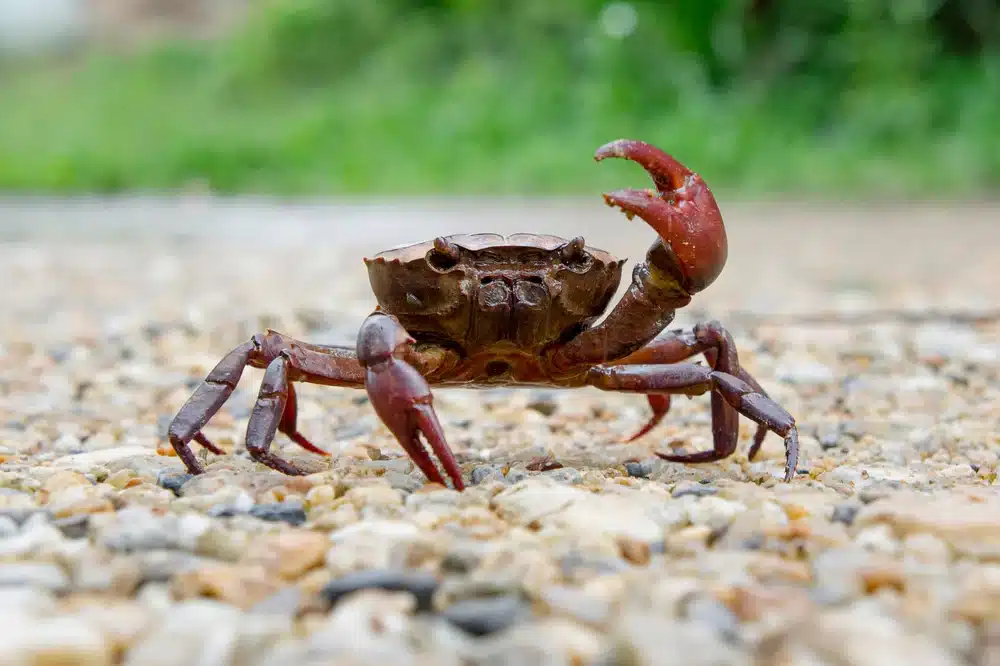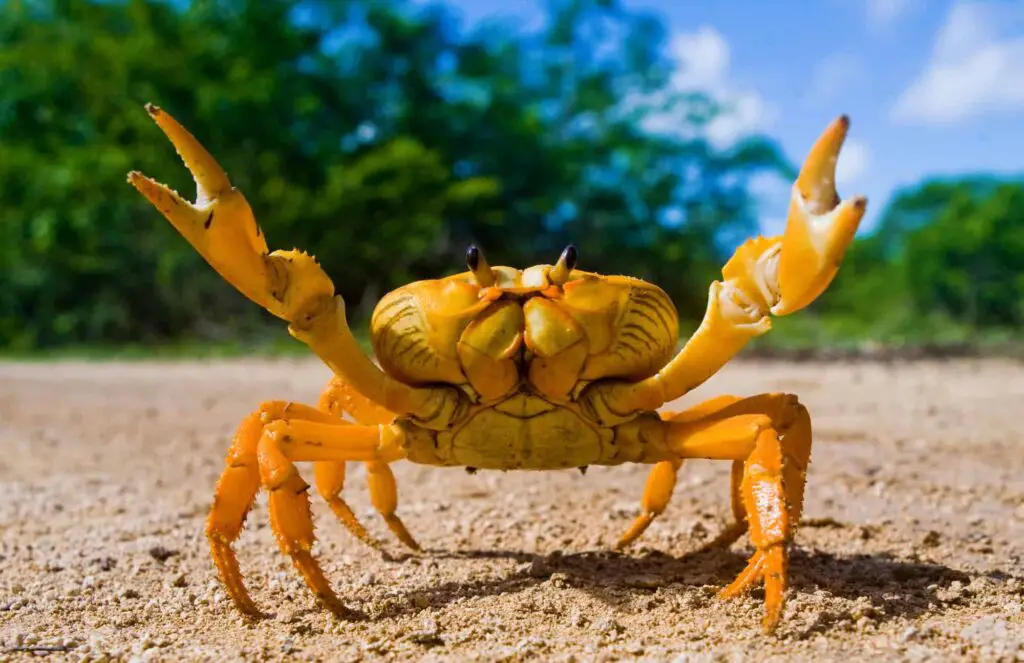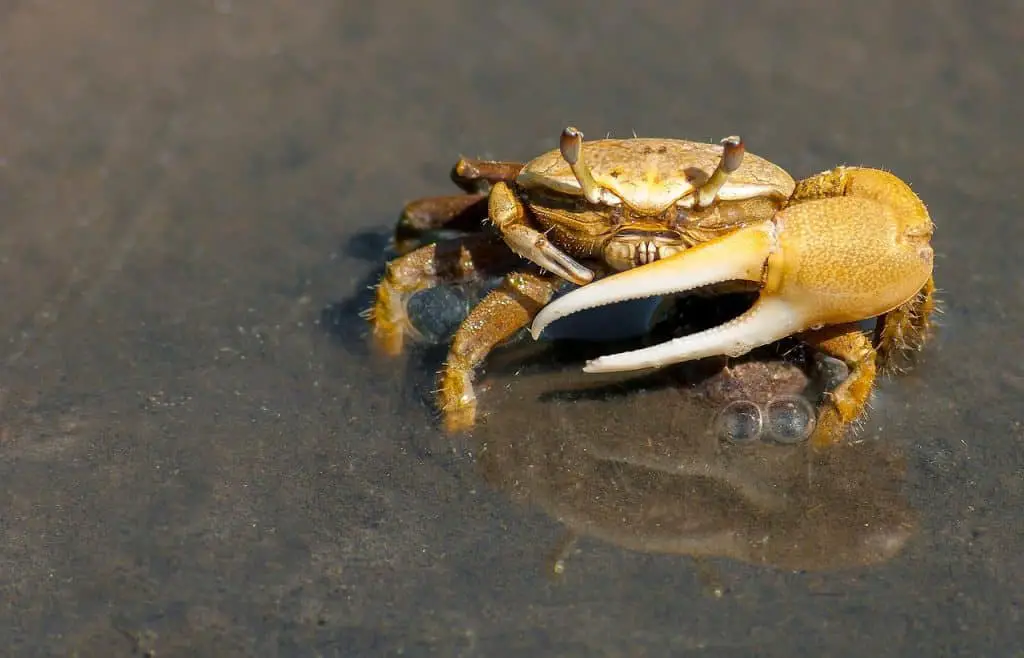How Many Legs Does A Crab Have

Introduction
How Many Legs Does A Crab Have: The question of how many legs a crab has may seem simple at first glance, but it opens the door to a fascinating world of marine biology and zoology. Crabs are among the most intriguing and diverse creatures found in our oceans, and their leg count is just one of the many intriguing aspects of their biology.
Crabs typically have ten legs. However, this seemingly straightforward fact is just the beginning of a deeper exploration into the world of these crustaceans. Their legs are not all created equal; they serve various functions beyond just mobility.
Crabs are members of the order Decapoda, which means “ten-footed.” These ten legs can be categorized into different types, each adapted for specific purposes. The front pair, known as chelipeds, are often larger and equipped with pincers that crabs use for capturing prey and defending themselves. The remaining eight legs are for walking and are usually smaller and more delicate.
Beyond their basic anatomy, crabs exhibit incredible diversity in terms of size, shape, and habitat. From the tiny pea crab to the colossal Japanese spider crab, these creatures have evolved to thrive in a wide range of environments, from the deep sea to shallow coastal waters.
Exploring the question of how many legs a crab has is an entry point into a world of biological wonders, where adaptation and evolution have created a myriad of unique and captivating species. In this journey, we’ll delve into the intricacies of crab anatomy, behavior, and ecological significance, uncovering the fascinating stories behind these enigmatic creatures.

Do crabs have 8 or 10 legs?
Crabs are crustaceans with 10 legs. The front pair of legs has strong, gripping claws on the end. The remaining eight are used for walking.
Crabs are often associated with having eight legs, but in reality, they typically have ten legs. The confusion arises from the fact that crabs have two pairs of specialized legs that differ in size and function. The first pair, known as chelipeds, are the larger and more robust ones equipped with pincers, which are used for capturing prey, defending against predators, and handling food. These chelipeds are often so prominent that they can give the impression of being the primary legs.
The remaining eight legs are designed primarily for walking and are generally smaller and more delicate. These walking legs allow crabs to scuttle across the ocean floor, explore their surroundings, and even climb. While the chelipeds are used for various tasks, the walking legs are essential for their mobility.
Crabs have ten legs, with two of them being specialized for specific functions. Understanding this distinction helps shed light on the unique and varied adaptations of these crustaceans, showcasing their remarkable ability to thrive in diverse marine environments.
Why do crabs have legs?
Walking legs: Crabs generally have three pairs of legs for walking on surfaces. While crabs are capable of walking forward, they generally walk sideways. Swimming legs: A crab’s last pair of legs are flat and help with swimming.
Crabs have legs for a multitude of crucial purposes, reflecting their intricate adaptations to life in aquatic environments. Each type of leg serves specific functions that contribute to their survival and ecological roles.
- Mobility: The primary purpose of most of a crab’s legs is mobility. Crabs use their legs to walk along the ocean floor, explore their surroundings, and find food. Their jointed legs provide the necessary flexibility and dexterity to move effectively in their habitat.
- Predation: Crabs are opportunistic predators, and their front pair of legs, known as chelipeds, are equipped with powerful pincers. These chelipeds enable them to capture prey such as small fish, mollusks, and other crustaceans. The pincers come in various shapes and sizes depending on the crab species and are essential for securing food.
- Protection: Beyond predation, chelipeds also serve as a defense mechanism. When threatened, crabs can use their pincers to fend off potential predators, making them a formidable adversary in the world of marine life.
- Sensory Functions: Crabs use specialized sensory hairs on their legs to detect changes in their environment, such as water currents, vibrations, and chemical cues. These sensory structures help them locate food, mates, and navigate their surroundings.
Crabs have legs as multifunctional tools that facilitate movement, hunting, protection, and sensory perception. These adaptations showcase the intricacies of their biology and their ability to thrive in diverse marine ecosystems.
What are crab legs called?
What are crabs legs called? Crabs have legs adapted to a variety of purposes. The first legs of most species have evolved into pinchers, technically called chelipeds, while the last pair of legs of some species have become small swimming appendages, called swimmerets or pleopods.
Crab legs are often referred to by different names, depending on their specific functions and characteristics. Here are some common terms used to describe various types of crab legs:
- Chelipeds: These are the front pair of legs on a crab and are often the largest and most prominent. Chelipeds are equipped with powerful pincers, which are used for capturing prey, defending against predators, and handling food. They are sometimes simply called “pincers” or “claws.”
- Walking Legs: The remaining eight legs of a crab are typically used for walking and are collectively referred to as “walking legs.” These legs are responsible for the crab’s mobility, allowing it to scuttle across the ocean floor and explore its surroundings.
- Swimmerets: In addition to the main legs, crabs also have specialized structures called “swimmerets” located on their abdomen. Swimmerets are smaller, more delicate appendages that help crabs with swimming and reproductive functions. They are not used for walking or predation.
- Paddle Legs: Some crabs, like the horseshoe crab, have specialized paddle-like appendages called “paddle legs” that help them swim more efficiently. These legs are adapted for propelling the crab through the water.
So, the term used to describe crab legs depends on their specific role and location on the crab’s body. Each type of leg has evolved to serve a particular function, contributing to the crab’s overall survival and success in its aquatic habitat.
Can crabs survive without legs?
Crabs commonly have the ability to regenerate lost limbs after a period of time, and thus declawing is viewed as a potentially more sustainable method of fishing.
Crabs are remarkable creatures, known for their ability to adapt and survive in various environments. While it might seem counterintuitive, crabs can indeed survive without legs, to some extent. Crabs have the unique ability to regenerate lost limbs, a process called autotomy. When a crab loses a leg due to injury or predation, it can regenerate a new one over time. This regrowth capability is vital for their survival, as they often encounter hazards in their natural habitats.
However, a crab’s ability to thrive without legs depends on several factors, including the severity of the injury, the crab’s overall health, and its access to food. Losing multiple legs or sustaining severe injuries can make survival more challenging, as mobility and predation risks increase. In some cases, crabs may adapt to a legless existence by relying more on their remaining appendages or developing alternative strategies for movement and protection.
While crabs can survive without legs thanks to their regenerative abilities, the extent of their survival depends on the specific circumstances and their ability to adapt to the challenges posed by their environment.
Can crabs grow new legs?
Crabs that have lost legs can regenerate them over time. The leg breaks off at a special joint. Before molting, a new limb bud, with all the remaining leg segments, grows out of the joint. After molting, the new leg is smaller than the others.
Crabs possess a remarkable ability to grow new legs, a process known as limb regeneration. This unique capability is essential for their survival, as crabs often encounter situations where they may lose legs due to injury, predation, or other environmental factors.
When a crab loses a leg, it initiates a regenerative process that involves cell division and tissue growth. The crab’s exoskeleton, which provides structural support, also plays a crucial role in this process. Over a period of several molting cycles, the crab gradually regrows the lost limb. During each molt, the crab sheds its old exoskeleton and secretes a new, larger one to accommodate the developing leg.
The regeneration process can vary in duration, depending on factors such as the crab’s age, species, and overall health. Younger crabs tend to regenerate limbs more quickly than older ones. Additionally, some species of crabs exhibit more rapid regrowth than others.
Crabs possess the remarkable ability to grow new legs through a complex process of molting and regenerative growth. This adaptation ensures their continued mobility and survival in the dynamic and often challenging environments they inhabit.
Are there any exceptions to the ten-legged rule in crabs?
There are exceptions to the ten-legged rule in crabs. While most crabs indeed have ten legs, there are certain species that deviate from this norm. One notable example is the family of crabs known as Raninidae, commonly referred to as “Frog crabs” due to their unique appearance. These crabs possess an elongated body and reduced abdomen, which gives them a somewhat frog-like resemblance.
Some male crabs of the family Dromiidae, also known as “Sponge crabs,” exhibit a similar variation. They possess a modified pair of legs in the front that are adapted for carrying sponges, a behavior associated with their reproductive strategies. These specialized appendages are not considered true walking legs.
While the ten-legged configuration is the standard among crabs, exceptions do exist. These exceptions provide fascinating insights into the diverse adaptations and behaviors that have evolved within this remarkable group of crustaceans.
Do male and female crabs have the same number of legs?
Male and female crabs typically have the same number of legs, adhering to the decapod configuration characterized by ten legs. These legs serve various functions, including locomotion, feeding, and reproduction. The front pair often evolves into specialized appendages for feeding or mating purposes, while the remaining eight are used for walking.
In certain species, particularly within the family Raninidae, known as “Frog crabs,” both males and females may exhibit a deviation from the standard ten-legged structure. These crabs possess an elongated body and reduced abdomen, leading to a unique appearance. As a result, they may have fewer than ten visible walking legs.
While the majority of crabs conform to the ten-legged rule, exceptions do exist. These variations provide valuable insights into the diversity and adaptability of these intriguing crustaceans. Nonetheless, the fundamental decapod body plan remains a defining characteristic for both male and female crabs across various species.
Are all crab species the same when it comes to the number of legs?
While the decapod configuration of ten legs is the standard among most crab species, there are exceptions and variations. Some species may exhibit deviations from this norm due to evolutionary adaptations and specialized behaviors.
For example, the family of crabs known as Raninidae, commonly referred to as “Frog crabs,” have a unique appearance characterized by an elongated body and reduced abdomen. These crabs typically have eight visible walking legs, which is fewer than the usual decapod count. Additionally, some male crabs from the family Dromiidae, known as “Sponge crabs,” have specialized modified legs in the front adapted for carrying sponges. These modified appendages are not considered true walking legs.
While the majority of crab species adhere to the ten-legged rule, exceptions do exist. These exceptions highlight the diverse adaptations and behaviors that have evolved within this fascinating group of crustaceans, showcasing the complexity and richness of the natural world.

Conclusion
The seemingly simple question of how many legs a crab has is just the tip of the iceberg when it comes to understanding these remarkable marine creatures. While it’s true that crabs typically possess ten legs, this fact is merely the beginning of a much more intricate story.
Crabs’ legs are a testament to nature’s ingenuity and adaptability. They have evolved to serve various functions, from capturing prey and defending against predators with their chelipeds to facilitating movement and exploration with their walking legs. This diversity in leg types showcases the evolutionary strategies that have allowed crabs to thrive in a multitude of aquatic environments.
Beyond their leg count, crabs exhibit an astounding array of species, each with its unique adaptations and behaviors. From the vibrant colors of coral crabs to the cryptic camouflage of decorator crabs, these creatures have found ingenious ways to survive and reproduce in their respective niches.
Crabs also play essential roles in marine ecosystems, serving as both predators and prey. Understanding their biology, including their leg structure, is crucial for appreciating their ecological significance and the delicate balance of life in the oceans.
While the answer to how many legs a crab has is relatively straightforward, it opens the door to a world of complexity and wonder in the realms of marine biology and natural history. The study of crabs continues to reveal the beauty and intricacy of our planet’s biodiversity, reminding us of the endless mysteries waiting to be uncovered beneath the waves.



